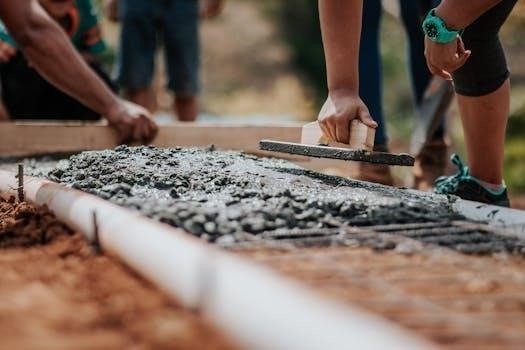Solera Awning Manual⁚ A Comprehensive Guide
Welcome to the comprehensive guide for Solera Awnings! This manual provides detailed information about Solera Classic, Hybrid, and Power awnings․ Discover step-by-step installation, operational procedures, maintenance tips, and troubleshooting advice․ Maximize your awning’s lifespan with our easy-to-follow instructions and enhance your RV experience!
Solera awnings are engineered to elevate your outdoor RV lifestyle․ This guide will walk you through everything you need to know about Solera awnings, from basic installation to advanced troubleshooting․ Lippert Components designs Solera awnings with the RVer in mind, focusing on ease of use, durability, and style․ Whether you have a Classic, Hybrid, or Power awning, this manual provides comprehensive instructions to ensure proper operation and maintenance․
Solera awnings provide shade, enhance privacy, and protect you from the elements․ Understanding the features and functions of your awning is crucial for a seamless camping experience․ We’ll cover securing the fabric, adjusting the awning, and even installing light kits to create the perfect ambiance․ With detailed diagrams and step-by-step instructions, you’ll be able to confidently operate and maintain your Solera awning, ensuring years of enjoyment and reliable performance on all your adventures․ Let’s dive in and make the most of your Solera awning!
Types of Solera Awnings⁚ Classic, Hybrid, and Power
Solera offers three main types of awnings⁚ Classic, Hybrid, and Power, each designed to meet different needs and preferences․ The Classic awning features a spring-loaded system, extending and retracting manually with a pull strap․ It’s a reliable and straightforward option for those who prefer a simple setup․ The Hybrid awning combines manual operation with powered features, often including a motor for extension and retraction while retaining manual adjustments for rafter arms․
The Power awning boasts a fully automated system, extending and retracting with the push of a button, providing ultimate convenience․ Understanding the differences between these types is crucial for proper operation and maintenance․ Each type has unique installation procedures, operational guidelines, and troubleshooting steps․ This section will outline the key features of each awning type, providing a foundation for the detailed instructions in subsequent sections․ Choosing the right Solera awning depends on your camping style and desired level of automation, and this guide will help you navigate those choices․
Solera Awning Components and Features
Understanding the components of your Solera awning is essential for proper operation, maintenance, and troubleshooting․ Key components include the roller assembly, which houses the awning fabric and facilitates extension and retraction․ The fabric itself is a durable material, often featuring an integrated light track for optional LED lighting․ Support arms provide structural support, and travel locks secure the awning during transit․ Depending on the model, you’ll find features like rafter knobs for adjusting the awning’s pitch and an internal motor for automated operation in Power awnings․
Hybrid awnings combine these with manual adjustment options․ Additionally, the awning rail is crucial for attaching the awning to your RV․ Universal hardware options are available for upgrades and customization․ Knowing these components and their functions will empower you to address issues, perform maintenance, and fully utilize your Solera awning’s features․ This knowledge ensures longevity and optimal performance, enhancing your outdoor RV experience․ Familiarize yourself with these parts before attempting any installation or repairs․
Installation of Solera Awnings⁚ Step-by-Step Instructions

Installing a Solera awning requires careful attention to detail․ First, ensure you have all necessary tools, including an electric screw gun, square screwdriver bits, and a rivet gun or nut driver bit․ Begin by inspecting the RV for an existing awning rail; if none exists, position and install one along the roof-wall line․ Next, carefully align the awning assembly with the rail, sliding the awning cord into the channel․ Secure the support arms to the RV side, ensuring they are at the desired height․
For power awnings, insert the drive head pin into the cap and secure with screws, repeating for the idler head․ When securing the fabric, extend and retract the awning several times to ensure proper alignment on the roll tube․ Finally, insert a screw through the fabric cord to secure it within the awning rail․ Remember to consult the specific installation manual for your awning model for detailed diagrams and torque specifications․ Prioritize safety throughout the installation process․

Manual Operation of Solera Classic Awnings
Operating a Solera Classic awning manually is straightforward․ Before extending or retracting, ensure the area is clear of obstructions․ Begin by releasing the travel locks located on each support arm․ These locks secure the awning during travel․ Next, loosen the rafter knobs which allow the arms to pivot freely․ Use the provided pull cane to gently unlock the roller mechanism․ Once unlocked, attach the pull strap to the awning roller․
To extend the awning, carefully walk it out using the pull strap, ensuring the fabric rolls out smoothly and evenly․ To retract, reverse the process by pulling the strap in the opposite direction, guiding the fabric back onto the roller․ Once fully retracted, lock the roller mechanism with the pull cane․ Tighten the rafter knobs and secure the travel locks on each arm to prevent accidental deployment during travel․ Regular inspection of the fabric and hardware is recommended for optimal performance․
Power Awning Operation⁚ Using the Internal Motor
Solera power awnings offer convenient operation via an internal motor․ To extend the awning, simply press and hold the extend button on your control panel or remote․ The motor will steadily deploy the awning․ Release the button when the awning reaches its desired extension․ To retract, press and hold the retract button․ The motor will then pull the awning back in․ Ensure the fabric rolls in evenly․
During operation, monitor the awning for any unusual noises or obstructions․ If encountered, release the button immediately to stop the motor․ Check for and remove the issue before resuming․ Avoid operating the awning in high winds or severe weather conditions․ If you are using the Solera Smart Arm, power up your mobile lifestyle with either the 12V power or 18V Battery Operated awning option․ Ensure you consult the manual for any specific power requirements or safety precautions․
Hybrid Awning Operation⁚ Combining Manual and Powered Features
Solera hybrid awnings offer a unique blend of manual and powered functionalities․ This provides flexibility in operation․ For powered extension and retraction, follow the instructions outlined for power awnings․ Use the control panel or remote to operate the internal motor․ Monitor the awning’s movement and stop immediately if any issues arise․

The manual features of a hybrid awning become useful in situations where power is unavailable or the motor malfunctions․ To manually extend or retract, first disengage the motor according to the manufacturer’s instructions․ This usually involves releasing a brake or clutch mechanism․ Once disengaged, you can manually extend or retract the awning using a pull strap or similar tool․ Be sure to exert even pressure to avoid damaging the fabric or frame․ Hybrid awnings provide a reliable backup system, ensuring you can always operate your awning regardless of the circumstances․ The hybrid awning is designed for use on Solera Classic, Solera Hybrid and Solera 12V power awnings․
Fabric Securing and Adjustment

Properly securing your Solera awning fabric is crucial for its longevity and performance․ Before securing, fully extend and retract the awning several times․ This ensures the fabric is square on the roller tube․ Uneven fabric distribution can cause stress and potential damage․
To secure the fabric, inspect the awning rail where the fabric cord is inserted․ Insert a 6 x 1/2 hex head screw through the fabric cord․ Also go through the fabric within the edge of the fabric on both ends․ This prevents the fabric from shifting or detaching during use or travel․ For manual adjustments, slightly loosen the screws․ Adjust the fabric’s position to eliminate wrinkles or sagging․ Once satisfied, retighten the screws securely, but avoid over-tightening․ Over-tightening can damage the fabric or the awning rail․ Regularly inspect the fabric and screws to ensure they remain secure․ Correcting minor issues promptly prevents larger problems and extends the life of your Solera awning fabric․ The Solera awning fabric is thicker and sturdier than others․
Solera Awning Light Kit Installation
Enhance your outdoor RV experience by installing a Solera Awning Light Kit․ These kits provide ambient lighting, perfect for evenings under your awning․ The installation process is straightforward, requiring minimal tools and time․
First, ensure you have the correct light kit compatible with your Solera awning model․ The LED light strip typically slides onto a special bead sewn into the Solera awning fabric․ Carefully insert the light strip into the designated track, ensuring it’s fully seated and secured․ Next, connect the wiring according to the manufacturer’s instructions․ Most kits require a 12V power source․ You can tap into an existing RV electrical circuit or install a dedicated power outlet․
Conceal the wiring neatly to prevent damage and maintain a clean appearance․ Use cable ties or adhesive clips to secure the wires along the awning arms or the RV’s exterior․ Test the light kit to ensure it functions correctly․ Adjust the brightness or color settings, if applicable, to your preference․ With the Solera Awning Light Kit, your RV patio becomes a welcoming space․
Troubleshooting Common Issues
Even with proper installation and maintenance, Solera awnings may encounter occasional issues․ This section provides solutions for common problems, ensuring your awning operates smoothly․ If your awning fails to extend or retract, check the power source for power awnings․ Inspect the fuse or circuit breaker and replace if necessary․ For manual awnings, ensure the travel locks are released and the rafter knobs are loosened․
Fabric sagging can occur over time․ To remedy this, adjust the fabric tension by carefully re-securing it in the awning rail․ Ensure the fabric is square on the roll tube before tightening․ If the awning fabric tears or rips, consider using a repair kit or replacing the fabric altogether․
Noisy operation can indicate worn or loose components․ Lubricate moving parts with a silicone-based lubricant․ Inspect the awning arms and hardware for damage․ If any parts are bent or broken, replace them promptly․ For power awnings, check the motor for proper function․ If the motor is unresponsive, consult a qualified technician․
Manual Override Procedures for Power Awnings
In the event of a power failure or motor malfunction, Solera power awnings are equipped with a manual override feature․ This allows you to retract or extend the awning manually, preventing damage and ensuring usability․ Before initiating the manual override, disconnect the power supply to the awning to prevent electrical hazards․
Locate the manual override access point on the power head assembly․ This is typically a rubber plug that conceals an access point for a manual crank․ Remove the rubber plug to expose the manual override mechanism․ Insert the manual crank handle into the access point․
Turn the crank handle in the appropriate direction to retract or extend the awning․ Use smooth, consistent motions to avoid straining the mechanism․ Retract the awning completely and secure it for travel․ It is crucial to consult a technician to diagnose the cause of the power failure or motor malfunction․ Remember to replace the rubber plug after use․
Maintenance and Care Tips
Proper maintenance is crucial for extending the life and performance of your Solera awning․ Regularly inspect the fabric for tears, mildew, or damage․ Clean the awning fabric with mild soap and water, using a soft brush to remove dirt and debris․ Avoid harsh chemicals or abrasive cleaners, as they can damage the fabric’s protective coating․
Periodically lubricate the awning arms and roller tube mechanisms with silicone-based lubricant․ This will ensure smooth operation and prevent corrosion․ Check all fasteners and hardware for tightness, tightening as needed․ Regularly inspect the awning rail for any signs of damage or corrosion․
When storing the RV for extended periods, retract the awning and secure it properly․ Consider using an awning cover to protect the fabric from UV rays and environmental elements․ Inspect the awning after severe weather, such as heavy rain or strong winds, to ensure no damage has occurred․ Following these maintenance tips will help keep your awning in excellent condition․
Solera Awning Replacement Fabric Installation
Replacing your Solera awning fabric can rejuvenate your RV’s appearance․ Begin by carefully measuring your existing fabric to ensure you purchase the correct replacement size․ Disconnect power to the awning and secure it to prevent accidental extension or retraction․ Remove the old fabric by carefully detaching it from the roller tube and awning rail, noting the attachment method for reference․
Clean the awning rail and roller tube to ensure a smooth surface for the new fabric․ Insert the new fabric’s cord into the awning rail, sliding it along the track․ Attach the fabric to the roller tube, ensuring it is square and centered․ Secure the fabric using screws or other provided fasteners, following the original configuration․
Extend and retract the awning several times to verify proper alignment and tension․ Adjust as needed to ensure the fabric rolls smoothly and evenly․ Secure the fabric at both ends to prevent slippage․ Inspect the installation for any loose connections or wrinkles․ With careful attention, you can successfully replace your Solera awning fabric and enjoy its renewed look․
